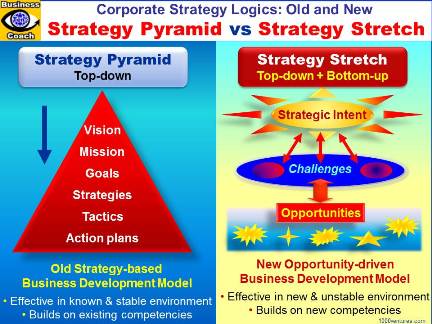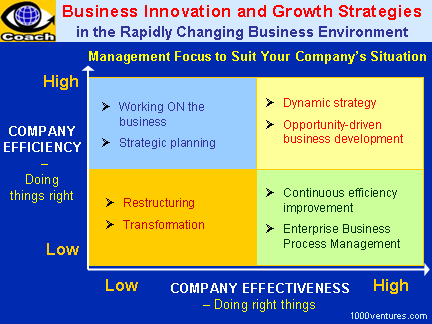|
Leadership and Management |
|
|

|
Choosing Between Strategy and Opportunity Approach
Adapted from "Changing
Strategic Direction", Peter Skat-Rørdam |
|
Use Strategy
Approach |
Use Opportunity
Approach |
|
Known environment |
Unknown environment |
|
Stable environment |
Unstable environment |
|
Building on existing competencies,
capabilities, products, markets |
Building on new competences,
capabilities,
products, markets |
|
Need consolidation |
Need
rapid growth |
|
Need stability and certainty |
Need
change, accept uncertainty |
|
Lack capacity for flexibility,
corporate venturing, and speed |
Established capacity for
flexibility, corporate venturing, and
speed |
|
 |
The Tao of
the Opportunity Approach |
-
YIN (passive, accepting side).
Outside-In: the will to listen to opportunity knocking,
searching for opportunities,
uncovering the Iceberg of Opportunities,
discovering opportunities, and building an
adaptive
organization and internal
capabilities to
pursue the
opportunities
-
YANG (active, aggressive side). Inside-Out:
pursuing opportunities,
the determination to
take
action and succeed,
rapid experimentation,
innovating to create tomorrow's opportunities, developing
disruptive products and creating winning
competitive strategies
|
|
5
Strategic Questions
You Should
Ask to Understand Where Your Business Is Going
by:
Jack Welch |
|
|
|
Creating Competitive Disruption
7
Strategies |
-
Find opportunities through
understanding trends of change.
|

|
SWOT Analysis
Questions To Answer |
|
|
|
4 Entrepreneurial Strategies
By:
Peter Drucker
Opportunities
"Every company meets new opportunities (and threats) daily. An employee
discovers an opportunity to sell a current product in a new market segment,
for example, or a competitor suddenly goes up for sale. Such opportunities
do not wait for the next strategy meeting."1 Some opportunities
may shape new challenges, influence your
strategic intent, and thus
change
your business set-up radically. Other opportunities that require incremental
changes may be defined as short-term projects intended to improve the
performance of the present business set-up.
Challenges
You should define a limited number of challenges each year
and necessary steps towards realizing your strategic intent. Though your
company "may have a vision of the path to the future, the challenges on the
road and road's direction may well change along the way. Challenges should
be specific, such as reducing time to market to 6 months, so that it is easy
to monitor whether targets are achieved. Challenges also need to be split
into a number of different projects."1
Entrepreneurial Leadership
In the
new era. of rapid changes and
knowledge-based enterprises, managerial work becomes increasingly
a leadership task.
In the increasingly
turbulent and competitive environment firms face today, a
new type of "entrepreneurial" leader distinct from other behavioral
forms of managerial leadership is required.
Entrepreneurial leadership
is the primary force behind
successful change.
Entrepreneurial leaders discover emerging business opportunities and empower employees
to act on the
vision. They execute through
inspiration and develop implementation capacity networks through a complex
web of aligned relationships...
More
18 Leadership Lessons from Colin Powell
Once the information is in the 40 to 70 range,
go with your gut. Don't wait until you have enough facts to be 100% sure,
because by then it is almost always too late....
More
Inspirational Quotes
from Great
Corporate Leaders
"No matter how deep a study you make, what
you really have to rely on is your own
intuition and when it comes down to it, you really don't know what's
going to happen until you do it."
–
Konosuke Matsushita
Case in Point
GE
Running the mighty GE enterprise, with its twelve major
businesses,
Jack Welch didn't seem like a
traditional manager. He seemed more like a
superleader: "My job is to put the best people on the biggest
opportunities and the best allocation of dollars in the right places. That's
about it. Transfer ideas and allocate resources and get out of the way."
When To Use
The Opportunity Approach
To decide
which business innovation concept is appropriate to a company, the
first thing to do is to ask whether the company is generally doing
the right things (effectiveness), but just needs to do them better
(efficiency), or whether it needs to do new things. It is important
to consider whether both fast results and the scale of change are
needed. It should first be asked whether the company is faced with
an evolutionary or radical change in its industrial sector.1
It does not
make much sense to pursue costly new opportunities if a company is
neither effective nor efficient. Cost-cutting and restructuring
measures should come first as a starting point of long-term
fundamental transformation – “creative destruction” – that
involves downsizing and simplifying, followed by regeneration of the
organization and strategy.
The
opportunity-driven business development approach aims at increasing
the effectiveness of a company through the pursuit of new business.
The opportunity approach is an alternative to the traditional
process of renewing business
strategy. This approach is also valid even for very successful
companies that are already both very efficient and very effective.
Even with a healthy business, external change is a constant factor.
Besides, it is often easier to obtain resource support for new
opportunities when a company is doing well.1
Strategic Innovation
Strategic innovation is a holistic systematic approach focused on
generating beyond incremental,
breakthrough or
discontinuous innovations. Innovation becomes "strategic" when it is an
intentional repeatable process that creates a significant difference in
the value delivered to consumers, customers, partners and the
corporation. A Strategic Innovation initiative generates a portfolio of
breakthrough business growth opportunities using a disciplined yet creative
process..
Strategic Intent
Strategic
intent is a company's vision of what it wants to achieve in the long
term. It must evolve on the basis of experience during its implementation. Strategic intent takes the form of a number of corporate
challenges, specified as short term projects and opportunities.
Opportunity-focused
Organization...
Reaching for the
Strategic Intent...
Searching for Opportunities...
Discovering Opportunities...
Pursuing Opportunities...
Assessing Your Management Opportunities...
Seeking the Optimum Balance of
Opportunities...
How To
Succeed in Business...
The Five Critical Success
Factors for New Ventures...
Harnessing the
Power of
Change...
The Experimental Approach...
Revenue Model...
Dynamic
Enterprise Strategy...
Turning Risks Into
Opportunities...
Ten-Point Summary...
Creative Leadership...
Case in Point
Dell Inc...
Case in Point
AT&T: Developing New
Credit Card Service...
Case in Point
Charles Schwab...
Case in Point
Google...
|